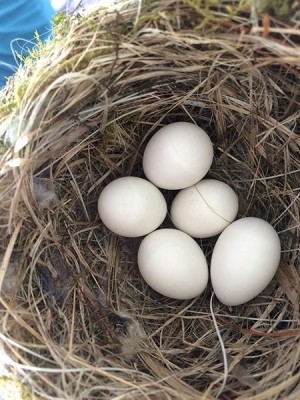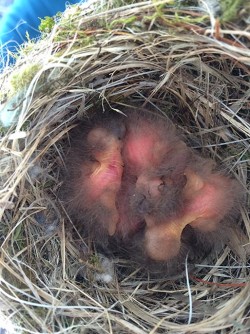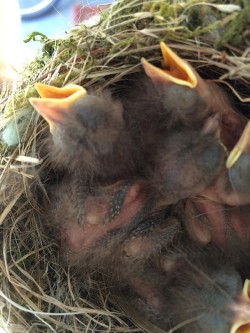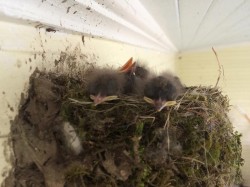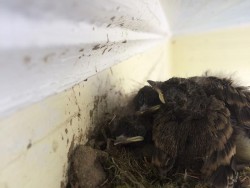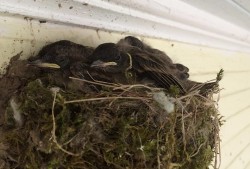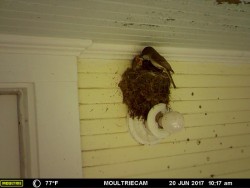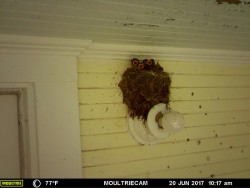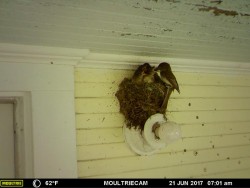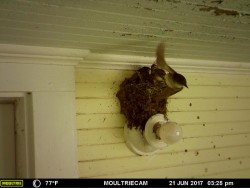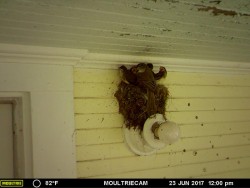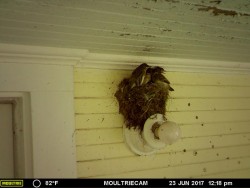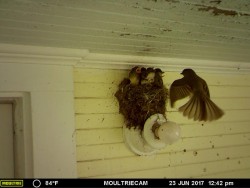This is more of an iPhone camera tale. I do have a game camera – a Moultrie M-550 – and I use it in somewhat clumsy attempts to glean information about which animals move through the yard and surrounding fields and woods. But try fitting a game camera to the ceiling of an old porch. Doesn’t work so well.
The subject here is a family of phoebes. At first it was just a female phoebe, working over the course of about two weeks at the end of April and into May to build her nest. Despite the hubbub surrounding our home, the phoebe chose our back porch, specifically the antique light fixture right next to the door, to build her nest. First came the mud, then the moss, then the dried grass and a bit of fur.
Not knowing much about phoebes when the nest-building began, I was surprised by how long it took the bird to finish building, then concerned when she disappeared for a while. Yes, we still heard the regular phoe-be calls from around the yard, but after the nest was done, the first week of May, the phoebe disappeared.
One morning – May 18, to be exact – I peered out the small kitchen window to find the phoebe sitting in the nest. When she left, I tiptoed out and slid my phone into the few inches of space between nest and ceiling to snap a photo, which revealed two eggs within the nest. Each of the next three days, my phone photos revealed an additional egg. After the fifth was laid, mother phoebe began incubating.
On June 7, my regular first-thing-in-the-morning glance out the window revealed the phoebe perched at the edge of the nest looking in. Out I went (once she was safely away) to sneak my photo, and there were the chicks, in a muddled mass of pink and yellow flesh that seemed vulnerable and hardly alive.
A few days later, I snapped another set of photos showing that the chicks were growing bigger and fuzzier. On June 13, temperatures rose to around 90 degrees, and the chicks were big enough to rest their heads on the edge of the nest and wait out the heat.
Ten days after the chicks hatched, their nest, which had seemed the perfect size for five eggs, appeared quite overcrowded. The parent phoebes had to hover just beyond the nest, or perch at the very edges of it, to feed the chicks. The babies’ eyes were still closed, but they were becoming boisterous, making baby phoe-be calls when food arrived.
Once the chicks became too big – and too aware – for me to approach the nest without feeling like I was invading their safety zone, I lashed the game camera to a pair of posts set atop a stepladder. By pure luck the lens was angled properly, and the camera later revealed about 1,000 images of the chicks and their parents.
By now, the chicks were regularly stretching their wings and shaking their heads, maybe either jostling for space or trying to shake off the tiny mites that were crawling all over nest and porch wall and ceiling. These, too, are visible in the later photos.
On June 19, the chicks opened their eyes. They took to perching precariously on the edge of the nest and seemed watchful now of their immediate surroundings. Mother and father phoebe arrived throughout the day – from pre-dawn to post-dusk – with various invertebrates clutched in their beaks to feed the five seemingly ravished offspring.
Four days later, we left home mid-afternoon with all five phoebe chicks still in the nest. When we returned two hours later, they had fledged. Somehow the game camera missed any fledging, but the regular calls of phoe-be! close to home assure us they are not too far away.


